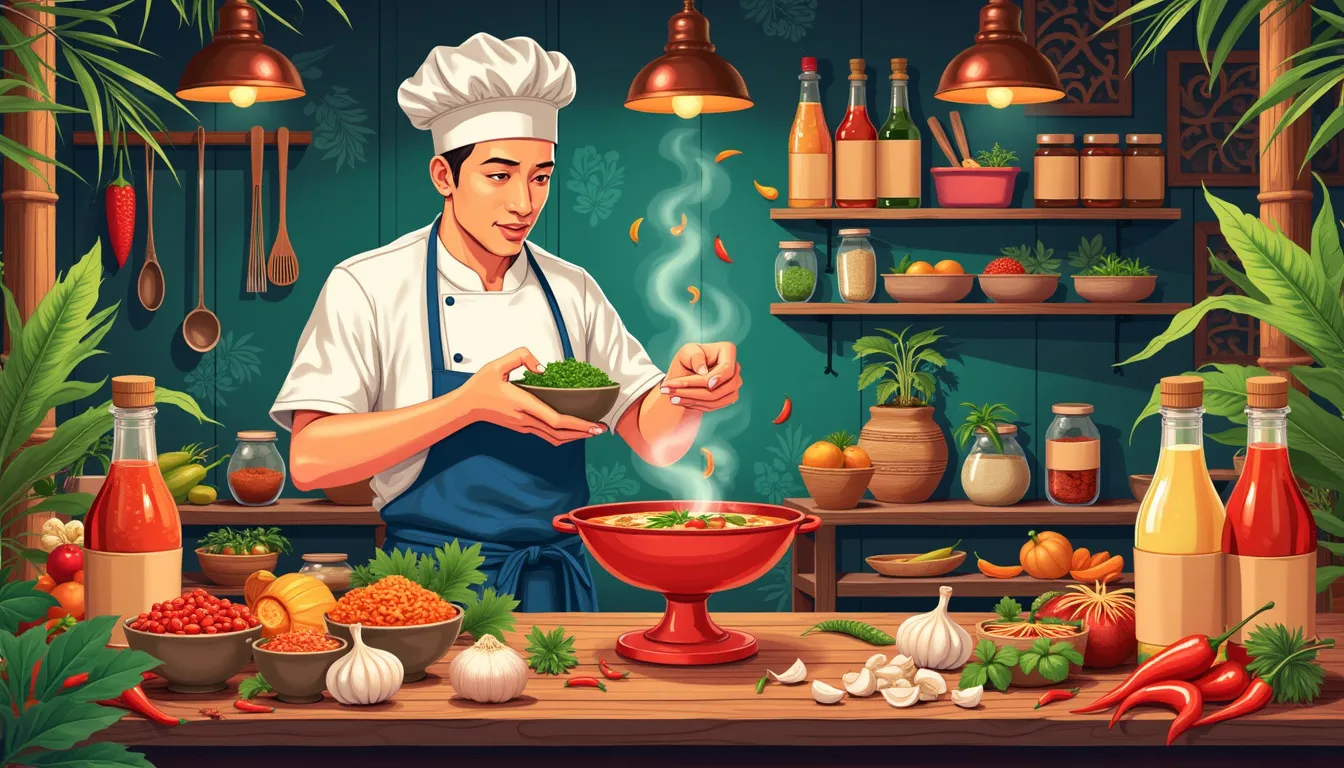An Introduction to Thai Sauce: The Heart of Thai Cuisine
Thai cuisine, renowned for its balanced flavors and aromatic qualities, offers a sensory journey unlike any other. At the heart of Thai cuisine lies the indispensable Thai sauce, a versatile and flavorful component that enhances both traditional and contemporary dishes. Whether it is a street food delicacy or a gourmet creation, Thai sauce brings a distinctive touch, marrying sweet, salty, sour, and spicy elements in perfect harmony.
The importance of Thai sauce cannot be overstated. It serves as a foundation for many dishes, from stir-fries and soups to salads and marinades. The variety of sauces available caters to different palates and culinary applications, showcasing the diversity of Thai flavors. Key ingredients commonly found in Thai sauce include fish sauce, soy sauce, tamarind, chilies, garlic, and sugar, each contributing a unique note to the overall profile.
The world of Thai sauce is as rich and varied as Thai cuisine itself. Understanding its role in enriching dishes and mastering its use can elevate your cooking to new heights, whether you are a seasoned chef or a home cook exploring the vibrant world of Thai flavors.
An Introduction to Thai Sauce: The Heart of Thai Cuisine
Overview of Thai Culinary Culture
Thai cuisine is a vibrant blend of colors, flavors, and aromas, known for its bold and dynamic character. It strikes a perfect balance between sweet, sour, salty, and spicy elements, which results in a delightful culinary experience. Much of the richness of Thai food can be attributed to its sauces, a quintessential component that brings depth and complexity to the dishes. Thai sauce is more than just a condiment; it’s an integral flavor enhancer that helps to define and distinguish the country’s gastronomy.
Importance and Versatility of Thai Sauce in Traditional and Modern Dishes
Thai sauce plays a pivotal role in both traditional and contemporary Thai dishes. Its versatility allows it to be used in marinades, stir-fries, soups, and even desserts. Traditional Thai sauces, such as Nam Pla (fish sauce), Nam Prik (chili sauce), and Kapi (shrimp paste), have been passed down through generations, each bringing its unique taste and aroma to the table. In modern cooking, Thai sauces are continually innovated upon, yet they still retain their essential role in flavoring and defining dishes.
For instance, a simple stir-fry can be elevated with a splash of fish sauce to introduce umami and saltiness. Beyond the kitchen, Thai sauce has found a place in the global culinary scene where chefs and home cooks alike use it to add an exotic twist to everyday meals. Its adaptability and impactful taste make Thai sauce an irreplaceable element in both traditional Thai and fusion dishes.
Key Ingredients Commonly Found in Thai Sauce
The magic of Thai sauce lies in its ingredients. Typically, Thai sauces feature a blend of aromatic herbs and spices, each carefully chosen to impart a specific flavor profile. Below are some key ingredients commonly found in Thai sauce:
Fish Sauce (Nam Pla)
Fish sauce is a staple in Thai cooking, known for its rich umami flavor and salty tang. Made from fermented fish and salt, it adds depth to soups, stews, and stir-fries. It’s an indispensable ingredient that provides a savory punch to many dishes.
Soy Sauce
Soy sauce is another crucial ingredient, often used in combination with fish sauce to create a balanced seasoning. Its fermented flavor complements the other elements, adding a touch of sweetness and complexity.
Lime
Lime juice is frequently used to introduce acidity and brightness to Thai sauces. It’s essential for balancing the overall flavor and adding a refreshing note to the dishes.
Garlic
Garlic is used generously in Thai sauces, contributing to the pungent and aromatic quality. It enhances the flavor profile and mingles well with other ingredients to create a robust taste.
Chilies
Chilies give Thai sauces their characteristic heat and spice. From mild to extremely hot, they can be adjusted according to the desired spiciness level, adding vibrancy and intensity to the dish.
Ginger and Galangal
These root spices provide warmth and a slightly spicy undertone. While ginger is more accessible, galangal offers a unique, sharp flavor specific to Southeast Asian cuisine.
Palm Sugar
Palm sugar is often added to Thai sauces to introduce a natural sweetness that counterbalances the salty and tangy elements. Its caramel-like flavor enriches the overall taste.
Tamarind
Tamarind paste contributes a sour and slightly sweet flavor, elevating the tanginess in sauces. It’s a unique ingredient that adds depth and complexity.
Conclusion
In conclusion, Thai sauce is the heart and soul of Thai cuisine, elegantly bringing together a medley of flavors that dance on the palate. Its importance and versatility allow it to enhance a multitude of dishes, whether traditional or contemporary. With ingredients like fish sauce, soy sauce, lime, garlic, and chilies, each Thai sauce offers a unique taste experience. Exploring Thai sauce is an adventure that reveals the true essence of Thailand’s culinary tradition, making every dish a flavorful journey. The next sections will delve further into the types of Thai sauces, their diverse flavors, and how to incorporate them into your cooking, ensuring you can bring authentic Thai flavors to your kitchen.
Popular Types of Thai Sauce: Diverse Flavors and Aromas
Fish Sauce: The Salty Soul of Thai Cuisine
Fish sauce, known locally as nam pla, is a cornerstone of Thai culinary tradition. Made by fermenting fish with salt, this potent liquid offers an umami punch that is indispensable in numerous Thai dishes. Its deep, savory profile adds layers of complexity to soups, curries, and stir-fries. Fish sauce is used as both a cooking ingredient and a table condiment, making it a versatile addition to your pantry. When selecting fish sauce, opt for brands that list only fish and salt as ingredients, such as Red Boat or Megachef, to ensure a pure and high-quality product.
Oyster Sauce: The Rich, Sweet Undercurrent
Oyster sauce, or nam man hoi, is another key player in Thai cuisine. This thick, dark sauce, made by simmering oysters in water and seasoning with salt and sugar, provides a rich and sweet flavor with a subtle hint of oceanic brine. It’s perfect for stir-fried vegetables, beef, and seafood dishes, where it imparts a glossy finish and a caramelized sweetness. When shopping for oyster sauce, look for versions that contain actual oyster extract, like Lee Kum Kee’s premium line, for a more authentic taste.
Chili Sauce: A Spicy Sensation
Chili sauce, referred to as nam prik in Thailand, comes in several varieties, each offering a unique blend of heat and flavor. Whether it’s the sweet and tangy nam prik pao (roasted chili paste) or the fiery nam pla prik (chili fish sauce), these sauces are essential for adding that quintessential Thai heat to dishes. They are commonly drizzled over grilled meats, used as dipping sauces, or incorporated into dressings for salads. For a reliable and flavorful option, consider brands like Mae Ploy or Pantai Norasingh.
Tamarind Sauce: The Tangy Touch
Tamarind sauce, or nam jim kaew, provides a unique tartness that distinguishes Thai cuisine from others. Made from tamarind pulp, this sauce introduces a tangy element that beautifully balances the sweetness and spiciness in dishes like Pad Thai and various grilled meats. Its slightly sweet and fruity flavor profile makes it an excellent accompaniment to anything that needs a zesty boost. When purchasing tamarind sauce, ensure that it is free from excessive preservatives or artificial additives for the best flavor.
Soy Sauce: The Umami Enhancer
Thai cuisine uses two main types of soy sauce: si-eiw dam (dark soy sauce) and si-eiw khao (light soy sauce). Light soy sauce is saltier and used for seasoning and marinades, while dark soy sauce has a richer color and is sweeter, often utilized for braising and adding color. Both types contribute to the depth of flavor and are often used together in recipes to create a balanced umami taste. Look for artisanal or traditionally brewed soy sauces to avoid those with excessive sodium or additives like Kikkoman or Healthy Boy Brand.
Peanut Sauce: The Creamy Companion
Peanut sauce, or nam jim satay, is most famously associated with Thai Satay, but its use extends far beyond. This creamy, savory, and slightly sweet sauce, made from peanuts, coconut milk, and spices, is perfect for dipping grilled meats, as a salad dressing, or even as a base for noodles. Its rich, nutty flavor adds a comforting layer of taste to any dish. Brands like Aroy-D and Mae Ploy offer high-quality peanut sauces ideal for authentic Thai cooking.
Unique Flavor Profiles and Enhancing Dishes
The magic of Thai sauces lies in their ability to elevate even the simplest of dishes. A splash of fish sauce can transform a bland soup into a flavorful masterpiece, while a dollop of chili sauce can turn a basic stir-fry into a fiery delight. The key to mastering Thai cuisine is understanding how to balance these diverse flavors. Whether it’s the sweet richness of oyster sauce or the tangy brightness of tamarind sauce, each type has its unique role in creating harmonious and vibrant dishes.
Tips for Selecting and Sourcing High-Quality Thai Sauce
When shopping for Thai sauces, quality is paramount. Here are some tips for ensuring you select the best:
- Read Labels Carefully: Opt for products with natural ingredients and avoid those with excessive preservatives, artificial colors, and high levels of sodium.
- Consider Authentic Brands: Trust well-established Thai brands known for their quality and authenticity, like Mae Ploy, Red Boat, and Pantai Norasingh.
- Check for Freshness: Fresh sauces will significantly impact the flavor of your dishes. Always check expiration dates and storage recommendations.
- Buy in Small Quantities: If you’re new to cooking with Thai sauces, start small to prevent waste and ensure you have fresh supplies.
- Explore Asian Markets: Specialty stores and Asian markets often carry a wider and more authentic selection of Thai sauces than general supermarkets.
Exploring the diverse world of Thai sauces can be a delightful journey for any culinary enthusiast. Each sauce offers a unique taste experience, and understanding their individual profiles can help you craft dishes that capture the authentic essence of Thai cuisine. Whether you’re stirring up a quick weeknight meal or preparing a feast for friends, the right Thai sauces will undoubtedly infuse your creations with unparalleled flavor and aroma.
Cooking with Thai Sauce: Recipes and Techniques for Authentic Flavors
Delving into the world of Thai cuisine through its sauces opens up a myriad of culinary possibilities. By mastering recipes and cooking techniques that utilize Thai sauce, one can recreate the authentic flavors that make Thai food so beloved. This section will provide you with step-by-step recipes for appetizers, main courses, and even desserts that showcase the versatility of Thai sauce. Additionally, you will learn cooking techniques that maximize the taste and aroma of these sauces, alongside tips for balancing flavors to achieve the perfect dish.
Appetizers: A Flavorful Start
Thai appetizers often feature bold flavors that excite the palate. Here’s a simple recipe to get you started:
Thai Chicken Satay with Peanut Sauce
Ingredients:
- 1 lb chicken breast, cut into strips
- 1 cup coconut milk
- 2 tablespoons red curry paste
- 2 tablespoons fish sauce
- 1 tablespoon sugar
- Wooden skewers (soaked in water to prevent burning)
For the Peanut Sauce:
- 1 cup creamy peanut butter
- 1/2 cup coconut milk
- 2 tablespoons red curry paste
- 2 tablespoons fish sauce
- 1 tablespoon soy sauce
- 1 tablespoon sugar
- Juice of 1 lime
Instructions:
- Marinate the chicken: In a bowl, combine coconut milk, red curry paste, fish sauce, and sugar. Add chicken strips, ensuring they are fully coated. Refrigerate for at least 1 hour.
- Prepare the peanut sauce: In a saucepan, combine all ingredients and cook over medium heat, stirring continuously until smooth and well-blended. Remove from heat and set aside.
- Skewer the chicken strips and grill or broil them for about 5-7 minutes on each side, or until fully cooked.
- Serve the chicken satay with a generous side of peanut sauce.
Main Courses: The Heart of Thai Dining
Main courses in Thai cuisine often center around a balance of sweet, salty, sour, and spicy. Thai sauces play a pivotal role in achieving this harmony. Here’s a favorite:
Pad Thai with Homemade Sauce
Ingredients:
- 8 oz rice noodles
- 2 tablespoons tamarind paste
- 3 tablespoons fish sauce
- 1 tablespoon oyster sauce
- 2 tablespoons sugar
- 2 tablespoons vegetable oil
- 2 cloves garlic, minced
- 1 cup shrimp or chicken, diced
- 2 eggs, beaten
- 1 cup bean sprouts
- 1/2 cup crushed peanuts
- 1 lime, cut into wedges
- 1/4 cup chopped fresh cilantro
- Chili flakes, to taste
Instructions:
- Soak rice noodles in warm water for about 30 minutes until soft. Drain and set aside.
- In a small bowl, combine tamarind paste, fish sauce, oyster sauce, and sugar. Mix until sugar is dissolved.
- Heat vegetable oil in a wok over medium-high heat. Add garlic and sauté until fragrant.
- Add shrimp or chicken and cook until nearly done. Push to one side of the wok.
- Pour beaten eggs into the wok and scramble until cooked through. Combine with the protein.
- Add the softened noodles and the sauce mixture. Toss everything together until the noodles are evenly coated and heated through.
- Fold in bean sprouts and remove from heat.
- Garnish with crushed peanuts, fresh cilantro, lime wedges, and chili flakes. Serve immediately.
Desserts: A Sweet Conclusion
Thai cuisine may not be as renowned for its desserts, but there are still a few that highlight the versatility of Thai sauce. Here’s how you can incorporate Thai sauce into a delightful treat:
Sweet Thai Mango Sticky Rice with Coconut Sauce
Ingredients:
- 1 cup glutinous rice (sticky rice)
- 1 1/4 cups coconut milk
- 1/4 cup sugar
- 1/2 teaspoon salt
- 2 ripe mangoes, peeled and sliced
- Sesame seeds for garnish
Instructions:
- Rinse sticky rice several times until the water runs clear. Soak in water for at least 4 hours or overnight.
- Cook the rice using a steamer for about 20-25 minutes until tender.
- In a saucepan, combine coconut milk, sugar, and salt. Stir continuously over medium heat until sugar is dissolved. Do not let it boil.
- Once the rice is cooked, transfer it to a bowl and mix it with about three-quarters of the coconut milk mixture. Let it sit for 20 minutes to absorb the flavors.
- To serve, place a portion of sticky rice on a plate, add mango slices, and drizzle with the remaining coconut sauce. Garnish with sesame seeds.
Cooking Techniques for Maximizing Thai Sauce
Understanding the techniques that enhance Thai sauce can elevate your culinary creations:
- Marination: Marinating proteins in Thai sauces can deeply infuse flavors. Ensure ample time for the marinating process to maximize flavor absorption.
- Simmering: Simmer sauces to intensify their aromatic qualities. This is particularly effective for curry-based dishes.
- Balancing Flavors: Thai cuisine is all about balance. Taste your dish frequently, adjusting the balance of spicy, sour, sweet, and salty to achieve a harmonious blend.
By following these recipes and techniques, you can bring the authentic and vibrant flavors of Thai cuisine into your kitchen. Whether starting with appetizers like Chicken Satay, savoring a classic Pad Thai main course, or indulging in the sweetness of Mango Sticky Rice, Thai sauces will elevate your dishes, making each meal a delightful culinary adventure.
Conclusion: Savor the Journey of Thai Sauce
Exploring the world of Thai sauce is more than just an education in culinary technique—it’s an adventure through the heart of Thai culture. Thai sauces exemplify the rich traditions and sophisticated flavors that make Thai cuisine beloved around the globe. By incorporating both traditional and modern applications, you can bring a piece of Thailand into your own kitchen.
A Symphony of Flavors
The versatility, complexity, and depth of Thai sauce allow it to be the star ingredient in a myriad of dishes. From the umami-rich fish sauce to the sweet and savory oyster sauce, and the spicy allure of chili sauce, each type of Thai sauce offers unique possibilities to enhance your culinary creations. Understanding how to select, source, and utilize these sauces will elevate your recipes to new heights.
Bringing Authenticity to Your Table
Whether you are a seasoned cook or a culinary novice, mastering the use of Thai sauce can transform even the simplest ingredients into a memorable meal. By following authentic recipes and perfecting your techniques, you can replicate the flavors of Thailand in your own home. Balancing the harmonious blend of sweet, salty, sour, and spicy elements is key to achieving the authentic taste Thai cuisine is famous for.
As you continue your culinary journey, remember that every dish prepared with Thai sauce not only brings rich flavors to your palate but also tells a story of Thailand’s rich cultural heritage. Embrace the adventure, experiment with various dishes, and most importantly, enjoy the flavorful world of Thai sauce.







